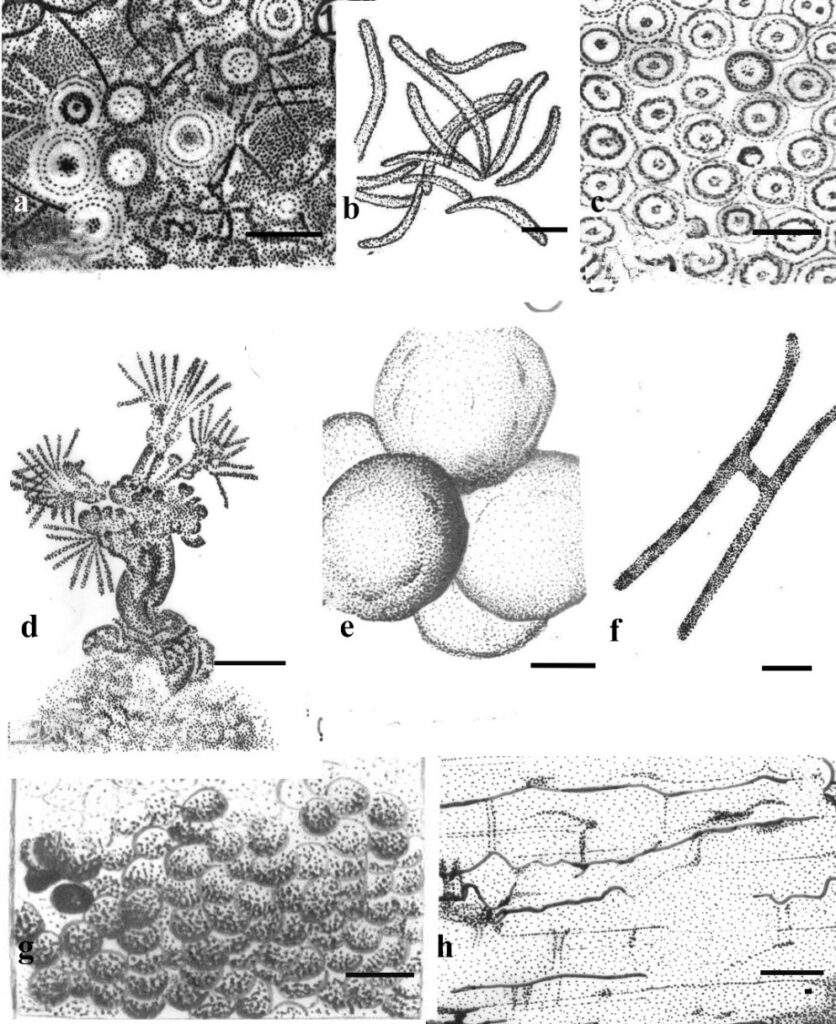Fungalpedia – Note 60 Salmacisia
Salmacisia D.R. Huff & Amb. Chandra
Citation if using this entry Noorabadi MT et al. (2023) New genera in 2008-2009. Mycosphere (in prep)
Index Fungorum, Facesoffungi, MycoBank, GenBank, Fig 1.
Based on phylogenies of LSU sequences using maximum parsimony and maximum likelihood analyses, Chandra &Huff (2008) introduced Salmacisia as a monotypic genus within Tilletiaceae, Tilletiales in Exobasidiomycetes with the type species Salmacisia buchloeana (Kellerman & Swingle) D.R. Huff & Amb. Chandra. The species had initially been described as Tilletia buchloëana by Kellerman & Swingle (1889). This pathogenic species infects buffalo grass (Bouteloua dactyloides) causing pistil smut and parasitic-induced hermaphroditism (Huff & Chandra 2008). It is the only species in the order Tilletiales known to have hermaphroditic effects (Chandra & Huff 2008).
Type species: Salmacisia buchloeana (Kellerm. & Swingle) D.R. Huff & Amb. Chandra
Fig. 1 – Stages of pistil smut life-cycle in vitro and in vivo (redrawn from Chandra & Huff 2008) a Teliospores produced from tips of mycelium growing in culture. b Blastospore-type secondary fusiform sporidia. c Teliospore. d Germinating teliospore with promycelium. e Teliospores of pistil smut exhibiting obscure tuberculate surface ornamentation. f Conjugating primary basidiospores forming a H-shaped bridge structure. g Cross-section of a teliospore filled ovary (smut ball). h Intercellular growth of pistil smut hyphae within buffalo grass vegetative meristem. Scale bars: a,c=20 μm, b,f =0.5 μm, c=20 μm ,d,e=5 μm, g=50 μm, h=40 μm.
Salmacisia buchloeana produces sori that originate from the ovaries of infected plants. These sori contain masses of dirty brown agglutinated spores (Chandra & Huff 2008). The teliospores are subglobose, globose, ovoid or elongated, pale yellow to light chocolate brown, 13–26 μm in diameter, usually with surface ornamentation. Teliospores germinate to produce a promycelium that gives rise to primary basidiospores that are either uninucleate and then fuse, or binucleate, giving rise to secondary basidiospores. These infect the host producing a systemic infection (Chandra & Huff 2008). No further species have been introduced to this genus which remains monotypic.
References
Chandra A, Huff D R. 2008 – Salmacisia, a new genus of Tilletiales, reclassification of Tilletia buchloëana causing induced hermaphroditism in buffalograss. Mycologia 100, 81–93. https://doi.org/10.1080/15572536.2008.11832500
Kellerman WA, Swingle WT. 1889 – New species of Kansas fungi. J Mycol 5,11–14. https://www.jstor.org/stable/3752851
Entry by
Maryam Tavakol Noorabadi, Center of Excellence in Fungal Research, Mae Fah Luang University, Chiang Rai, Thailand.
(Edited by Kevin D Hyde and Eric H.C. McKenzie)
